
ONTARIO

Toronto
NO PART OF THE FOLLOWING
ARTICLE AND PHOTOGRAPHS
MAY BE REPRODUCED WITHOUT
PERMISSION FROM THE AUTHOR ©
(May also have been known as "White City")
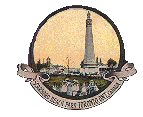
This popular park was located in the Beaches area just west of present-day Scarborough. It was in what is now part of The City of Toronto between Kew and Balmy beaches. Situated south of Queen Street on the Lake Ontario waterfront, it was bounded by Leuty Avenue on the west side and MacLean Avenue on the east for a total expanse of 15 or 16 hectares. The land had been owned by Thomas O'Connor who operated it as The House of Providence Farm, and upon his death in 1895, it was willed to The Sisters of St. Joseph's. After being declined by Toronto council as being too expensive, the Sisters sold it to Harry and Mabel Dorsey in 1906 for $160,000. The Dorseys wanted to open an amusement park on the site patterned after New York's Dreamland and Luna parks at Coney Island. So, under the name Toronto Park Company, they invested $600,000 to build the largest park with the most attractions ever put in the Beaches area. In March of that year, a contest was held to name the spot which then opened June 1st, 1907 as Scarboro Beach Park.
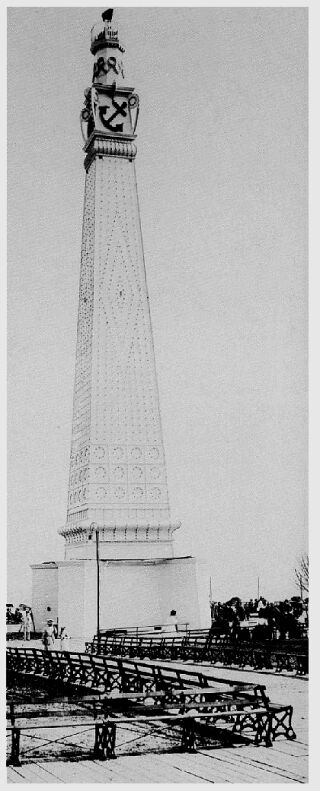
|
Dominant to Scarboro Beach Park was an illuminated 30-metre tower. (Some sources give 38 metres.) A beacon on top could be seen from many kilometres around. This tapered obelisk had anchors sculpted in relief near the top, along with other designs in lights on each of its sides. These may be seen in the close-up photo. 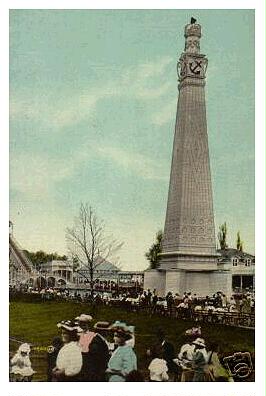 It was blown down in a storm sometime in the early 1920s and replaced or likely partly salvaged, but as a shorter version of this one. The replacement may be viewed in the aerial photo, near the end of this article. As can be seen by comparing the photos, the base and initial section of both towers is the same, hence the assumption that the lower section was salvaged. |
There was a boardwalk on three sides of the amusement area, with a "Chutes" ride dividing the eastern boardwalk in two. Park benches ringed the boardwalks, as may be seen in the close-up "Tower" photo. Attractions lined all three of the sides. Over the park's life, they included "Air Ship Tours", a theater, freak shows, "Electroscope", "Circus Gallery", a penny arcade, Snake Show, several shooting galleries, photo studios, "Laugh Gallery", and "Joyland - House of Nonsense".
Some of the first motion pictures in the area were shown here beginning in 1907. There were also "Pompeii", "1889 Johnstown Flood" & "1906 San Francisco Earthquake" live displays or presentations. The disasters' stories were told to patrons through the use of audio and lighting effects, while being shown the destruction on miniature sets. Another attraction was The "Monkey Circus".
The Boardwalks
|
Scarboro Beach Stage and West Boardwalk circa 19-0s 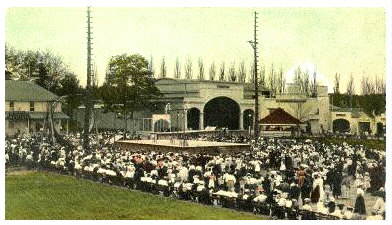
|
Crowds enjoy acrobats on a sunny afternoon.
The west boardwalk may be seen in tne background.
The building behind the red-roofed structure just
right of Center is Joyland, while the large portal
to its left is for Cascades. Note the loop structure
at Center Left beside the stage.
|
|
This was taken farther down the west boardwalk from
the above picture. The acrobat stage is closer to the
red-roofed structure just right of Center, but out of
frame to the right. Patrons enjoy music coming from the bandstand under the arch at the left. At Centre Right background lies The Scenic Railway. |
Scarboro Beach West Boardwalk circa 1910 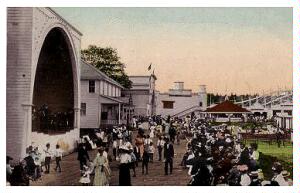
|
|
Scarboro Beach North Boardwalk circa 19-0s 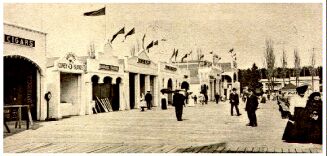
|
This view is taken from the distant end of
the west boardwalk, as seen in the above photo.
Three of the buildings on the left are "Cigars",
"Coney Island Red Hots" (5 cents), and "Laughing
Gallery". Note the weigh scale outside the "Cigar"
concession.
|
|
Farther along is looking toward the park's entrance
which lies in the distance just on the other side
of the last building on the left. That building is
the Scenic Railway station.
In the Center Right background, are attractions on the East Boardwalk. Those buildings may be seen in the Shoot the Chutes photo shown after this "Boardwalks" section. |
|
This hand-tinted view is taken from a slightly
different angle and closer in from the above. It
gives another view of the buildings on the left
which include a "Snake Show", "Rifle Range"
(shooting gallery), theater, and other
concessions. The bandstand is at the right, with the "Circle Swing" tower visible above its roof. |
Scarboro Beach North Boardwalk 1910 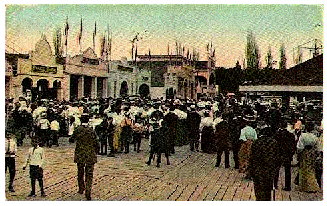
|
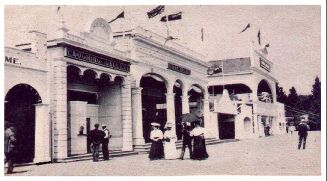
|
Scarboro Beach North Boardwalk circa 1910 |
| Here is a closeup of the buildings at the eastern end of the North Boardwalk. The largest three are The "Laughing Gallery", "Penny Arcade", and at the far right is The "Scenic Railway" station. |
Another early attraction was The "Infant Incubator Institute" which showed babies being reared in glass cases. The third side of the boardwalk, along with a seawall, formed the beach/amusement area boundary. All the park's buildings, tower, and walkways were outlined in thousands of lights which, at night, were easily visible from far out into Lake Ontario. Some of this may be seen in the night photo, farther on.
Rides, which cost 10 cents in the initial seasons - save for one free one, included a "Tickler", "Whirl of Pleasure", and a "Shoot-the-Chutes" with a sign at the top saying simply "Chutes". It had an over 20-metre high run that splashed down into a long lagoon. (Some sources give an almost 30-metre height, but this seems to be exaggerated.) At the bottom of the drop was an overpass walkway and viewing gallery much like today's chutes rides, except that onlookers standing there didn't get wet.

|
Shoot the Chutes
and Boardwalk Circa 19-0s 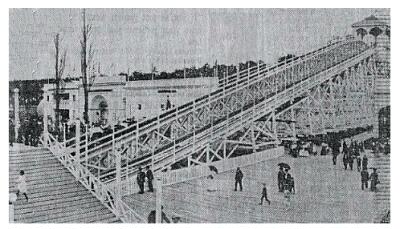 In the background are buildings for the (right to left) Whirl of Pleasure, the Disasters presentations, and The Electroscope. |
This fuzzy image shows the Chutes inclines and part of the pedestrian overpass. |
|
Spectators watch as a boat skims the
water in this early shot of the lagoon.
To the right are the Bump the Bumps
attraction and carousel building. At the
left is The Whirl of Pleasure building.
Note the string of lights at the extreme Top
Center and the light standards receding into
the distance along the boardwalk.
|
Shoot the Chutes
1907 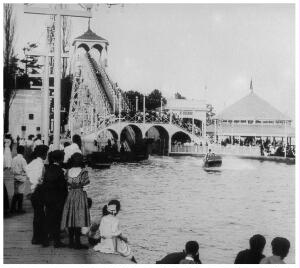
|
|
A boat descends the incline on its
journey to the run-out pond. To the
right is the side of the Bump the
Bumps structure. The small bullding
partially visible in the center background
may have been the pumphouse for the
Chutes ride. The woods in the background hide the miniature railway layout. Its station lies to the right behind the carousel building out of frame to the right of the Bumps building. |
Shoot the Chutes
Circa 1907 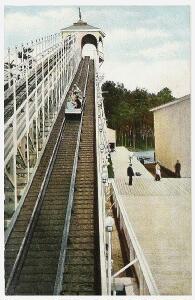
|
|
Shoot the Chutes
and Boardwalk Circa 19-0s 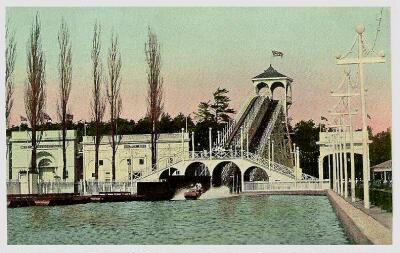
|
A Chutes boat has just run under the pedestrian
overpass and hit the water. More of the Bump the Bumps
structure to the right is visible in this shot. The carousel
building is to its right. To the left of the ride is the East Boardwalk. Seen right to left are the Whirl of Pleasure, the Disasters presentations, and at the far left is The Electroscope. Compare this image with the night shot, farther on. |
|
A boat sails across the lagoon in this
close-up view which affords a better look at
the overhead walkway. Trellis work has been
added above the top most platform. Contrast how much the trees in the background have grown as compared to the earlier photos above. |
Shoot the Chutes
and Overpass 1923 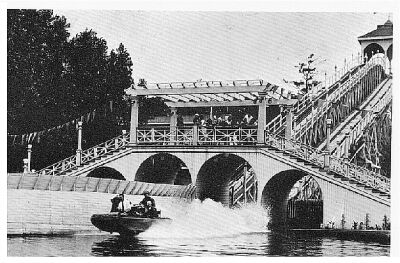
|
The park had a long, winding "Tunnel of Love" dark ride called "Cascades". The station and loading platform were in a building which in part ran under the park's roller coaster. This attraction was a `wet' dark ride with small boats moving around a course through various scenes. As the boats passed certain points, they would trigger things like a kicking mule that would suddenly be illuminated, and when it kicked, a loud bell would sound to scare riders. Another gag was a devil character that would appear from behind a red curtain.
There was also a Traver "Circle Swing". Introduced in 1903, the ride consisted of six or eight gondola-shaped cars with four 2-passenger wicker benches sporting decorative wrought iron sides and a tasselled, awning-style canopy. Each was supported by four cables attached to a central tower 20 metres high. (One source says 25 metres.) The top of the tower rotated and as the ride turned, the cars would swing out at an angle, thus lifting up and giving an airplane sensation. (See the Hanlan's Point, and Dominion Park articles for pictures of this model.)
The Traver company later offered a modern update to this ride by replacing the gondolas with airplane-shaped cars utilizing electric motor-turned propellers. This was The "Seaplane De Luxe" model, but a 1923 or 1925 aerial picture of the park still shows the "Circle Swing" cars in place, so the park never updated the ride. (See this photo farther on.)
Another ride, "Bump the Bumps", which was referred to simply as The "Bumps", consisted of a long inclined, undulating, polished wood slide. Riders would go over or around the mounds scattered down the ride which would throw them in different directions. This was the only ride in the park for which there was no charge.
|
Scarboro Beach Park at Night circa 1910s 
|
In the center is The Shoot-the-Chutes.
At the bottom of its run, the openings for
the boats to pass underneath the spectators'
walkway are ringed in lights. At Center Right are The Bump the Bumps and just visible, the carousel building. Left of The Chutes are Whirl of Pleasure, the Disasters presentations, and far left is the Electroscope. |
Just off the beach was located a covered, Looff carousel which likely was new with the park in 1907. (Other sources say this unit was built in 1903, which means the park acquired it used.)
It's interesting because the speed regulator was a streetcar controller. It may have been that the carousel was at first steam or other powered, and after The Toronto Railway Company (TRC) bought the park in 1912, they may have converted it themselves to run on electricity, thus the use of the streetcar power regulator. Given that the company had employees whom knew about, and repaired, the electric trams, this would not be impossible. This ride apparently ended up at Lakeside Park in Port Dalhousie after Scarboro Beach Park closed, but likely as early as 1921. (See Lakeside Park.)
|
Scarboro Beach circa 1910s  The Tower and a bath house may be seen at far left in this busy beach photo. In the center & right background are the park's restaurant and the carousel building. In the far background may be seen the top of the Chutes ride. |
The TRC take-over may have signalled an increase in the use of electricity because at night, as seen in a previous image, the park was illuminated via strings of lights hung from draped cables. As well, the rides and buildings were outlined in light bulbs.
The park boasted two roller coasters during its run. The first was the 400-metre long "Scenic Railway" built in 1907 for the park's opening. It may have been a J. A. Griffiths/George Crane or an L.A. Thompson model. The coaster consisted of hills and dips, with part of the layout inside a cavern. Here, scenes of equatorial jungles and the arctic could be viewed. This coaster lasted until 1918. The following year it was replaced with The "Dips" which ran on the same site at least until 1925, the year the park was sold. It's unclear if this was a new ride or simply a reworking of The "Scenic Railway". Photos suggest The "Scenic Railway" was not modified to produce The "Dips", but at the very least, the ride was renamed. However, it may be that the ride was reprofiled in a way not evident in photographs, or that the cavern section and/or scenes were removed, or perhaps that new trains were added. Research continues.
|
Close-Up Aerial View of Scarboro Beach Park 1923 or 1925 
|
|
Here, the Dips Coaster is seen.
To the right is the station and the park's
entrance. To the left is The "Penny Arcade",
"Laughing Gallery" and other midway buildings.
At the bottom is the picnic area with the
Circle Swing to the right.
|
The entrance for the ride was right next to the main gate. It and the later coaster layout may be seen in full in the aerial photograph, farther on. The coaster station is immediately to your left of the park entrance, as viewing the photo. The rear of the station may be seen in the Athletic Field photograph, farther on.
|
Scenic Railway 19-0s 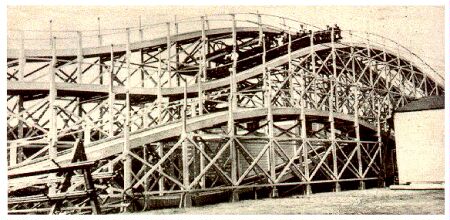
|
| Here is the coaster in action with a train having just crested a hill. |
The location of the "Scenic Railway" station is somewhat in contention. Photos I have seen show the ride to be next to the athletic field, located between the stadium outfield bleachers and the boardwalk buildings. However, one description places the station for this ride on the other (western) side of the main park entrance. I believe that to be incorrect.
On the other hand, the "Double Down" photo, below, shows the back of the coaster layout and there are no field or bleachers. So either the field was put in after the ride, or this photo was taken of a coaster which was located on the far side of the entrance. I believe that this is the field and that the bleachers have not yet been installed. Clues that this location is the western one are the road (which appears to be the entrance one), and the tram car seen beyond it at Upper Left. If this ride was on the east side of the entrance, the tram tracks would be abreast of the coaster layout, not diagonally opposite. It is likely that the field looked this way in its early days and was upgraded after the 1912 acquirement by The Toronto Railway Company.
|
Scenic Railway 19-0s 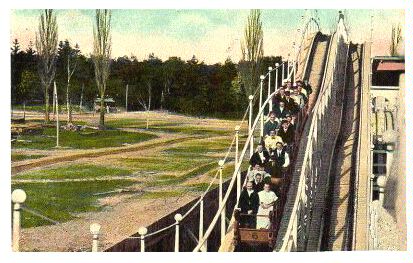
|
|
This shows a train midway into a `double down',
a drop which levels out a bit part way down and
then drops again. The empty track to the right
illustrates this better. Given the layout shown in other photos, It is likely that the train has crested the lift and is into its first drop. This image and the previous two show this to be the highest part of the track. Note the number `6' on the lead coaster car and the tram car in the far left background. |
To add to the location confusion, the picture below is supposedly of the Scarboro Park "Scenic Railway" entrance. The image places this ride's entrance at one of the corners of the boardwalk, at about a 45-degree angle to the buildings on either side. However, no other boardwalk pictures bear this out. There was an angled building in this location but it was not the roller coaster entrance. It is instead shown as "Joyland" (likely a funhouse) or as "House of Horrors". Visible in the photo below are miniature railroad tracks seen In front of the coaster entrance. However, the park's train was actually well east of The "Scenic Railway" in an isolated part of the park.
|
The entrance to a "Scenic Railway"
is shown here. This photo is
supposedly from Scarboro Beach,
but is actually from Montreal's
Dominion Park. |
Dominion Park Scenic Railway circa 1907 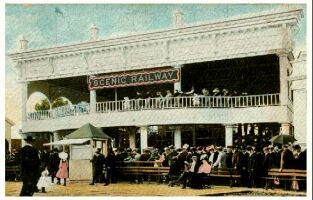
|
The above photo is actually that of The "Scenic Railway" at Dominion Park in Montreal. If you compare this photo with those in the Dominion Park article, you will see that the structures are identical, as are the side buildings. The building to the right was a funhouse or laughing gallery, while the studio to the left is unidentified. No other photos or maps of Scarboro Park show those two side buildings at this park, but do so at Dominion Park, so it is definitely a picture taken at the latter.
The miniature train tracks at Dominion are in that exact spot, and even the ticket booth is the same style and in the same spot. Again no other photos from Scarboro show its train running in that location, but they do so at Dominion. Finally, photos of the Scarboro Beach "Scenic Railway" show it used a different station design.
It is speculated that the Dorseys contracted the same company(s) that built Dominion to build their park. The parks have very similar layouts and attractions. They also opened only a year apart. Perhaps the Dorseys were given one or more photos of Dominion Park as examples, and somehow the photo of The "Scenic Railway" got into some Toronto archive where it was incorrectly labelled as having been taken in Scarboro Beach Park. Apparently the Dorsey family owned both Scarboro and Dominion parks, which would explain a lot.
Games at Scarboro included the aforementioned penny arcade and shooting galleries plus a hoop toss, weight game, fish pond, and several ball games (one of which may have been "Japanese Roll-Downs"), among others.
Food concessions selling "red hots" and popcorn dotted the boardwalk. The "Coney Island Red Hots" seen in a boardwalk photo farther back, was replaced by what may be "Electrical Derby" (seen farther on in the "airplane" photo). Interestingly, during the 1910 season, J.D. Conklin managed the park's concessions. This may have been the Jim Conklin, later of Clark and Conklin Shows, that would adopt Joe Renker and his brother Frank within a decade. Joe Renker became Joe Patty" Conklin, probably Canada's best-known carnival owner.
Another to-be-famous concessions manager was N.X. Nathanson. He would eventually create two country-wide movie theater chains, Famous Players and Odeon. When at Scarboro Beach, Nathanson introduced the ice cream cone. He also later managed the concessions at Dominion Park.
There was a 1300 square-metre restaurant in the park. The Scarboro Inn Cafe had a large open-air verandah which overlooked the beach on one side, a stage and bandstand on another, the "Chutes" lagoon on a third, and on the fourth, a lawn with the carousel building at its far boundary. Dances were held in the cafe, often referred to as "The Pavilion". Two acts mentioned for the bandstand were singer Maggie Barr and D'Urbano's band.
All this was in addition to the many open areas with grass and flowers, one of which contained the bandstand and the large uncovered stage upon which acrobats, animal acts, magicians, clowns, high-wire performances, and others were featured. One picture shows a loop-the-loop bicycle stunt show. Next to the ride & game areas and separated by a seawall, was the sandy beach which is what drew persons to the area in the first place. There was a boat rentals building and a bathing pavilion that could accommodate 250.
Canada's first airshow was held over this beach in September, 1909 (one source incorrectly gives 1908). A single Curtiss biplane called The "Golden Flyer" was piloted by Charles Willard. Curtiss had built his first design in 1908 ("June Bug"), and evolved The "Flyer" as a stripped-down version of that. In fact, The "Flyer" had come into being only a month before the Scarboro airshow as an entry for a French aerial exhibition and competition.
At Scarboro Beach, Willard took off and landed two times, while a third attempt resulted in a crash into the lake due to electrical failure. The pilot and plane survived. Charles would return to Toronto in the summer of 1911 where MacLean's Magazine author James Haverson would write about a flight taken with him and predict that flying would be "... far from the rare and uncanny thing it is today." Here in the 21st century, airshows are Canada's Number One spectator sport.
|
The Golden Flyer 1909 ? 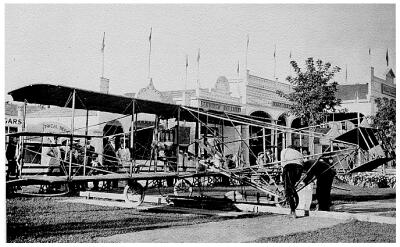
|
|
Here are Charles Willard and an assistant attending to
their aircraft. Note the box-kite style of design,
as was prevalent in that era. Underneath is a tricycle
landing gear with the nose wheel in a wooden guide trough. It sits in front of the North Boardwalk and faces across the open grassy area in the center of the park toward the beach. In the background is the Cigars outlet, while to the right are what may be "Electrical Derby" (a game?), The "Laughing Gallery", "Penny Arcade" and at far right is the "Scenic Railway" station. |
Another large area comprised the Picnic Grounds. Located on the east side of the park in a tree-shaded, fenced area, it was bordered by a miniature steam railway running a narrow gauge locomotive and rolling stock. The passengers boarded at a station just behind the carousel building which was right next to the beach. The train then went out into the picnic area and through a switch to a somewhat square layout with indented sides and rounded corners.
This track ran around the perimeter of the picnic grounds and along a wooden fence which formed the MacLean Street border of the park. Upon returning to the switch, the locomotive and cars would pass over it as if to do another trip around, stop, and back up the branch track to return to the station. From the Scenic Railway photo, farther back, it appears that this train or another may have run around the boardwalk area at one times. However, as already discussed, that photo is likely of Dominion Park, and no other source shows the Scarboro miniature train running on the boardwalk.
Associated with the park was The Toronto Athletic Field. It was situated next to, and just outside, the park. In fact, the end of the field that contained the main entrance ran parallel to Scarborough Beach Boulevard which ran right to the park's entrance gate. The stadium consisted of a club house, a partially covered grandstand, and bleachers on two other sides. One set of these abutted the roller coaster structure and had a press box on its upper level. In the middle was a race track and a central field, where baseball, football and lacrosse were often played. The park even had its own lacrosse home team: The "Toronto's".
|
The Toronto Athletic Field circa 1910s 
|
| This shot was taken from the middle of the athletic field. The light-coloured area in the foreground is the south-eastern end of the race track. The building at Center Left is the park's entrance. Next, in the background, is The Circle Swing ride. The arched structure is the roller coaster station. The ride's lift hill may be seen at Lower Right and one of the return tracks at Center. Various boardwalk buildings are seen in the background, with the park's tower appearing to rise among them. |
The track was used for bicycling and often hosted six-day(!) non-stop bicycle marathon races. Later, a wood velodrome was added. One of its most famous participants was Canadian Bill Peden, whose nickname was "Torchy", for his red hair. Not only did he take part in and win these races, he also competed internationally. With his partner, Spencer, they won the 6-day bicycle event at Madison Square Gardens in New York City three years in a row. Later in his career in 1931, he set the world's bicycle speed record at just under 120 kilometres per hour!
In 1912, The Toronto Railway Transit Company, which had previously owned a near-by competing operation (Munro Park), bought The "Toronto's" lacrosse team. They also bought the park, making Scarboro a "trolley park"; that is, one used to promote trolley business during off-peak times. The street car loop stopped near the covered entrance and offices to the park. Just outside & east of the main part of the park were rail yards and a car barn.
In 1919 a new car barn capable of storing 16 to 20 cars (depending upon their size) was built closer to the park's entrance. As well, there was an office car located just across the tramcar tracks. It had been brought from the Exhibition entrance after the December 1916 King East Division carhouse fire. (It is assumed The Canadian National Exhibition is being referred to here.) That fire was caused by a newspaper which had been innocently left behind one of the coal-fired stoves used to heat the streetcars in winter. It went undiscovered and after the car returned to the carhouse upon finishing its daily run, sometime later the paper caught fire. In turn, the car itself burned and that spread to other streetcars. The following year (1917) a nearby residence was purchased and turned into additional TRC offices.
In 1921 The Toronto Transportation Commission (TTC) took over The Toronto Railway Company. They were not interested in the park and presumably did not put any money into it, so patronship declined. It's possible that they began selling off rides, because it appears that the park's carousel went to Lakeside Park in 1921, although the carousel building may still be seen in later photographs.
|
Aerial View of Scarboro Beach Park 1923 or 1925 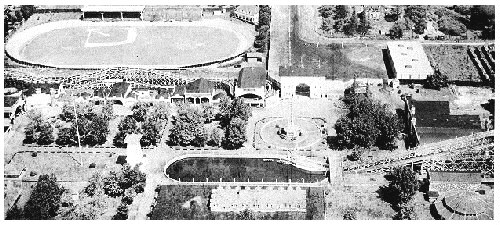
|
|
From Upper Left to Lower Left: The Athletic Field and Seating, Dips Coaster, Midway Buildings, Picnic Area, Main Performance Area, and reduced-size Park Tower. From Center Top to Center Bottom: Park Entrance, Circle Swing ride, Chutes Pond, Restaurant. From Upper Right to Lower Right: Streetcar Barn, Disaster Exhibits, Shoot the Chutes, Bump the Bumps, and Carousel Building. |
With the escalation of land value and the resulting increased taxes, the park was sold to the city in 1925. Sometime after this, it was resold to real estate developer Provident Investment Company, which was actively buying up estates in the area for housing developments. It's not entirely clear if the park continued to operate after these sales or not, because one reference gives the closing of the park as 1930. Despite the fact that other sources imply a closing year of 1922 or 1926, the best documented seems to be that the park operated until 1925, with a final day of September 12th. The 1930 closing date is clearly wrong because newspaper ads of 1926 advertise new homes on the former property.
Tenders were advertised for the removal of amusement devices and then another for removal/demolition of buildings. The boathouse and wooden bicycle track were apparently excluded, but no reference has surfaced as to what eventually happened to them.
The developer bulldozed the site, new streets were laid out, and houses were built. The city purchased back a portion between Hubbard Boulevard and the lake to include in its new Beaches Park which opened in 1932.
Nothing of this amusement park remains today, but one may still go down Scarboro Beach Boulevard to Hubbard Boulevard and swim in the lake or enjoy Beaches Park there. Scarboro Boulevard passes right through where the entrance gates to the park once were and over the former "Circle Swing" and "Chutes" lagoon locations. Hubbard Boulevard (named for the park's general manager, Fred Hubbard), is said to occupy the exact location of the beach side of the park's boardwalk which had run past The Scarboro Inn. At the foot of Scarboro Beach Boulevard lies a plaque placed there in 1993 by The Toronto Historical Board. It commemorates the amusement park which once brought happiness to thousands.
Interestingly, when the city took over Hanlan's Point and its ferry boats in 1926, they in turn passed the administration of them over to the Toronto Transportation Commission. The TTC ran that park until its demise in the mid 1930s.
|
Thanks to Toronto historian, Mike Filey for major information
on Scarboro Beach. Additional details came from authors Mary Campbell and Barbara Myrvold. Thanks to Ben Fullerton of Fletcher's Lake, Nova Scotia for postcard scan work. The "Tickler" advertisement is courtesy of John Wood from Philomath, Oregon. His grandmother and grandmother's father were from Canada. |
Return to the
Closed Canadian Parks Index
